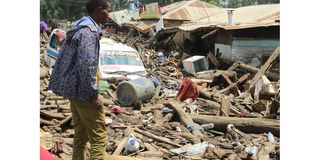Hanang floods: A wake-up call for disaster preparedness

What you need to know:
- The Hanang disaster serves as a reminder for urban planners on the need to prevent flood-prone areas from being transformed into settlements; and the fact that disaster management efforts must extend to hamlets and remote villages as well
Arusha. In normal times, few could imagine devastating floods and mudslides of the magnitude that recently rocked Katesh in Hanang and other districts of the Manyara region.
The district, largely inhabited by livestock keepers, does not attract much rain and is generally prone to occasional severe droughts—at least three to four seasons in a decade.
Even during years of heavy rains, there are hardly alarming floods that could sweep away people, livestock, houses, logs, and huge rocks at once.
During the 1997/98 El Nino rains, though, Hanang district was temporarily cut off from direct transport to Arusha after a section of the Babati-Arusha road was flooded.
Other than that, what impacts Hanang in such scenarios of heavy rains are slippery terrains due to the nature of the soils found there.
The district has no permanent rivers, save for water streams originating from Mt Hanang, the district’s water tower, now almost 'milked' dry by the growing human and livestock population.
On the mountain slopes and elsewhere, seasonal gorges could be flooded during heavy downpours. This has not led to a major concern, as the threat would be over in a matter of hours.
But for the residents of Katesh, the district headquarters, and Gendabi, a township some 20 to 25 kilometres away, this was not the case on December 3.
Also read: What we know on Mount Hanang
Felician Mombo, a retired parastatal executive, was at his home village of Jarodom on the outskirts of Katesh on that fateful morning.
He woke up at around 5am, preparing to go to church. Although the area had seen rain for days, there was nothing alarming outside.
He thereafter went inside to call somebody to drive him to the prayer house. It was then that he heard a loud bang similar to a thunderbolt.
His family house is just a few kilometres from the edge of the forest reserve on Mt Hanang, a protected area under the Tanzania Forest Service (TFS).
The forest belt, which extends to higher altitudes, is the source of some water streams that make up the Jarodom River, which is also known as the Himiti River.
Before Mr Mombo could know what to do next, another bang hit his compound. That was a huge log swept onto his house by the raging water from upstream.
“I was shocked to see strong waves of water cascading down with logs and huge rocks. I feared the worst and started shouting for help,” he told journalists.
It was then that he realised it was too late to reach the church for prayers. He started praying on the spot as the calamity hit, not only his home but the entire village.’
“In about 20 minutes, the worst appeared over with some disquiet. But that was not the case. The raging waters would soon be replaced by mudslides, he said.
Mr Mombo was one of those villagers affected by the early morning deluge that swept houses, killing people and their livestock at Katesh. He and his family were lucky.
Scores of others lost members of their respective families, had their houses flattened, livestock killed, and other properties destroyed or swept away.
The raging waters cascaded downhill towards Katesh town, knocking down houses, shops, market stalls, and vehicles, killing more people amid massive damage to property.
It was more or less the same case at Gendabi village on the western side of the towering Mt Hanang. Katesh is on the southern slopes of the mountain.
To date, according to statistics from the government, at least 89 lives have been lost in the disaster, which has shocked the nation.
What could have been the cause of the catastrophe never seen in Hanang and other parts of Manyara and that may have been elsewhere in the country before?
There are varying versions, but all of them point to the geological formation of the area, specifically the towering Mt Hanang.
There had been talk of a volcanic eruption, especially from the locals, who said they heard a loud bang before the destructive deluge came down, rolling from the mountain.
There is a reason for this, although there is no proof so far. The 3,240-meter-high Hanang is a volcanic mountain that, incidentally, sits in the geologically volatile Rift Valley.
But geological experts deployed to Hanang had their version. They have associated the disaster with what appeared to be the disintegration of the rocks, possibly from the pressure of water.
The rocks could have been saturated with water after the heavy rains that preceded the disaster and they could have disintegrated under pressure from water in aquifers.
Hanang residents inspect a vehicle that was swept away by mudslides in the December 3 deluge
The mudslide, which caused much havoc in equal measure, has been attributed to the rain-soaked and fragile soils on the mountain.
Alfredo Shahanga, also a resident of Jarodom, believes the narrative, saying he also heard a cracking bang that was followed by gushing water and mud.
Jarodom village alone lost about 15 people, including schoolchildren. Most of the victims, unlike at Katesh town centre, were asleep when the disaster came knocking.
Although the break-up of the rocks narrative holds water—the flash floods came down with huge boulders that uprooted trees—there could be other reasons behind the calamity if casualties are anything to mind.
Preliminary observations indicate that many of the deaths occurred in the houses that were built within the natural water pathways in both Katesh and Gendabi.
Perhaps not much is known about the drainage pattern on the two townships on the slopes of Mt Hanang and that, indeed, some permanent rivers once existed in the two localities.
Until the 1980s, Katesh had a river called Himiti, or Jarodom, cutting through the town. During the peak of the dry seasons, it had only droplets of water or simply dried up.
Thereafter, as the town’s population grew, especially after the town was elevated to a district headquarters, water from the source was piped to supply the growing town and its suburbs.
With no water flowing for most of the year, the natural water path was left at the mercy of land grabbers. People simply constructed houses, not aware of the consequences.
They eventually became victims of the December 3 deluge; the gushing waters simply followed the natural drainage ways that had existed since time immemorial.
The same case happened at Gendabi, where the flash floods simply cut the expanding settlement into two parts. Here was also the case of huge boulders and logs brought down.
President Samia Suluhu Hassan, who visited the calamity-hit areas only days after it struck, insisted that the Hanang floods were a wake-up call to disaster preparedness.
Weather patterns, she said, were unpredictable, and, therefore, no one could have predicted the Hanang calamity, which claimed so many lives.
However, the Head of State, who cut short her official visit to Dubai because of the catastrophe, implored Tanzanians to enhance local capacity in disaster management.
She said when addressing residents of Katesh on December 7 that although nobody could have predicted the Hanang flash floods, something could still be done.
“We must develop early warning systems before disasters strike. We need to build our capacity for detection of the coming tragedies of such nature,” she said.
Allan Moses, an activist based in Arusha, echoed this, saying that although the Hanang disaster was an Act of Mother Nature (a natural cause), Tanzanians must always be alert to such calamities.
Disaster management should not only be confined to urban areas but extend to the hamlets and remote villages. The regional and district officials have to be prepared.
“The government should establish zonal offices for such emergencies to mitigate disasters. People should always be prepared for such calamities, he told The Citizen.
The Hanang disaster is also a wake-up call for urban planners who have to ensure flood-prone areas are not turned into settlements.




